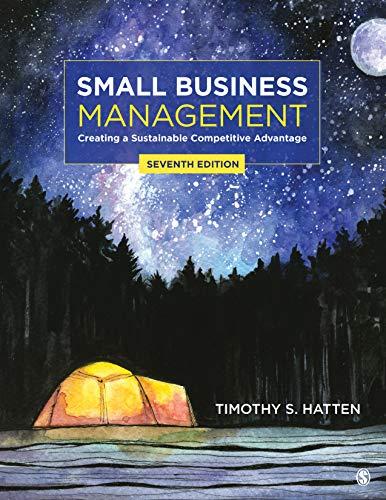Question
Ernie Sampson, a new Vice-President, started work at a national equipment services company. Being from another industry, he felt that he needed to learn a
Ernie Sampson, a new Vice-President, started work at a national equipment services company. Being from another industry, he felt that he needed to learn a lot. He asked to spend a couple of weeks at one of their largest nearby locations with about 350 employees. He wanted to spend time in each department, so the local HR Manager and management team set up a plan for him to do so.
In some departments he'd spend half a day or a full day, as well as, an hour or two with certain staff depending on how much there was to participate in. For example, he spent half a day in Sales, but also an hour with the Reception/Switchboard person to learn about incoming calls, visitors and other demands in that role.
He took this opportunity seriously and got quite involved, doing as many tasks as he could (without endangering anyone or misdirecting any data). The staff responded very well and enjoyed having such an open and willing executive work with them. Ernie enjoyed his assignment immensely and returned to the Corporate Office bursting with ideas.
Ernie felt that the orientation he received was tremendous for introducing him, an industry newcomer, to what the work of the organization really was. He was so enthusiastic that he suggested to Gail Ferber, the VP of HR, that this would be a great model for new employee orientations. In such a unique industry, most newcomers were from other industries and learning the whole picture this way would be quite effective. They had similar operations nationally, so this could be a widespread initiative. Also, while teamwork was already strong, they wanted to keep building it.
Gail floated the idea at the monthly national HR conference call and received an enthusiastic response. The HR Managers saw the value and three volunteered to be the team to work on it. (This team project approach was one they used quite effectively and often.) A series of conference calls was planned for the team to scope out the project, set a basic plan, and allocate who did what and how often they would report to each other. They also set up input requests to the other HR Managers on aspects of their locations' orientation processes that were working well.
At the second conference call, they had a roughed-out plan for a structured two week "tour of duty" plan, whereby each new employee would spend time in their home department, but then a specific period of time in each other department. Further refinements included:
- An overview CD, and orientation binder with a plan, sequence and timetable for these "visits".
- Contact "hosts" (and back-ups) in each department, to support and teach the newcomers.
- A background chart of the work flow, and information on their overall work site.
- An employee handbook (one was already in place), basic safety information and other relevant information, all which could be contained in their binder.
The schedule enabled them to spend half their time in their home department and the other half "on tour", visiting other areas at less busy times for those groups (weekly, each department had 3-4 very busy days, and 1-2 days that were a bit calmer).
It took some time to get commitment and input and from all departments. Also, a debate arose over whether the process should take 2 versus 3 weeks to complete. Next, coordination and documentation tasks were addressed, as there needed to be "adult supervision" from HR to ensure the plan worked.
The plan was rolled out successfully, but the HR team sought feedback from staff to improve it. Tracking and following up with newcomers on missed visits was a challenge. On the other hand, new employees could count on a clear, comprehensive introduction to the company. Managers could count on the fact that all new staff had been briefed well and consistently on company norms and expectations.
Address the three questions below (base your answers on course material AND on your personal experiences and sensibilities about workplaces):
- What is your view of this plan? What else could have been included?
- Would this type of plan work, or not work at your employer? Why?
- What impacts can orientation have on new employees and the organization?
Step by Step Solution
There are 3 Steps involved in it
Step: 1

Get Instant Access to Expert-Tailored Solutions
See step-by-step solutions with expert insights and AI powered tools for academic success
Step: 2

Step: 3

Ace Your Homework with AI
Get the answers you need in no time with our AI-driven, step-by-step assistance
Get Started


